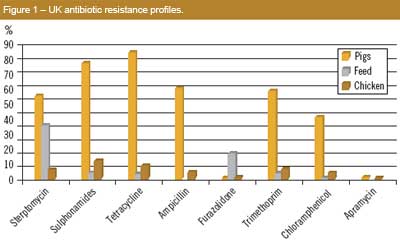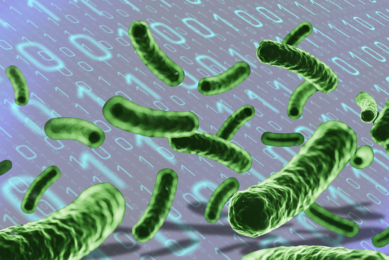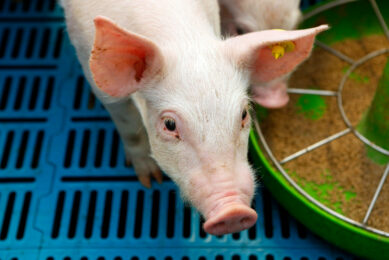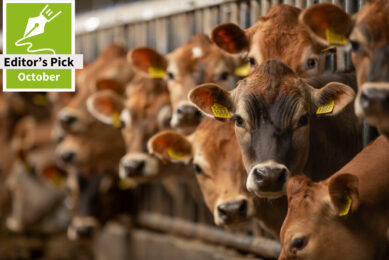Reaping better effects of organic acids in feed

Most problems found on farms today are related to the health of the animal and not to the feed. We have computer programs to optimise feed formulations and feed mills that produce them well. But through the feed we can also optimise animal performance by reducing pathogen colonisation in the gut of the animal, using protected organic acids.
By Murray J Hyden, Chief Technical Officer Kiotechagil, Reading, England
We expect our animals to eat well, convert feed efficiently and grow or produce rapidly. In the past 20 years growth rates have increased dramatically and feed conversion rates have fallen sharply as animals have been genetically selected and bred for performance. However, we have failed to consider the most important aspect of production and that is the intestine. Fast growth and concentrated feeds put enormous stress on the intestine, and when this organ is stressed, it may result in the occurrence of diseases. The concerns over salmonella, escherichia and campylobacter are the result of expecting the intestinal development to match that of the genetic selection processes.
When disease problems were first identified they were treated with antibiotics, then antibiotics were used to keep the diseases away until eventually the bacteria became resistant to the antibiotics. The world responded by banning antibiotics in animal feed too late and now we need an alternative.
In Figure 1 we can see high levels of antibiotic resistance in pigs and significant resistance in poultry but low levels in feed. This confirms that feed is not the source of infection. There are more bacterial cells in the intestine of a healthy animal than there are cells in the animal. It therefore means that you need a microbiological solution to keep the animals healthy.
What are the alternatives?
Probiotics are a source of healthy lactic acid producing bacteria, such as the Lactic Acid Bacteria (LAB), and can compete with potential pathogens to physically or chemically exclude the enteropathogens. However, probiotics are not always 100% effective. In poultry the stomach or crop/proventriculus has a low pH, which is used as a natural defence mechanism, and this area is colonised by acid tolerant probiotics, but at a low density. However, the enteropathogens that we need to control do not normally colonise this area of the intestine. In monogastrics the more neutral large intestine, colon and rectum are more suited to potential enteropathogen colonisation.
Probiotics require an acid pH for optimum colonisation. Under disease situations or high calcium diets like lactation or layer/breeder rations the pH will not support acid-loving bacteria and probiotics will not be fully effective.It is important to remember that all bacteria require four things to grow:
• Temperature – The body temperature of pigs and chickens are ideal.
• Nutrients – The gut of any commercial animal is full of nutrients.
• Water – All animals drink.
• pH – The pH of the small intestine is perfect for E. coli.
The pH of the hindgut is ideal for salmonella. High calcium rations result in a high pH, about 8.0 – ideal for salmonella.Therefore, probiotics will not work in the large intestine, colon or rectum of pigs without some assistance.
Organic acids
There is no such thing as a feed acidifier. Published data on the buffering capacity of different nutrients determines that you would require 25 litres per tonne of 1 Molar Hydrochloric acid (stomach acid) to lower the pH of a typical animal feed to pH 3. Most potential enteropathogens are killed at pH 3 (the pH of the monogastric stomach and crop/proventriculus of a bird.
Hydrochloric acid would be too corrosive to use in the feed mill so we would need to select the weaker and less corrosive organic acids such as formic and propionic. Longer chain organic acids such as citric or benzoic acids have progressively less acidifying power and require higher inclusion rates.
We can still use organic acids to protect our animals. There is a remarkable amount of research available to support the use of organic acids as alternative control strategies for enteropathogens. However, organic acids have certain practical limitations. The major limitation is, in fact, that they are digestible as energy sources. But sometimes they do work, so therefore these acids do not simply acidify the feed or the gut, but must have some other function.
We know, for example, that acids work very well when administered with probiotics.
Understanding the mode of action
Some organic acids such as formic and propionic acids can have a direct effect on E. coli or other enteropathogen infections. We have data to show that they can work, and in many cases work very effectively, so we need to understand how they work if we want to use them to the best advantage. They are the most popular replacement for antibiotics in Europe (Figure 2).
Simply adding acids such as formic acid in drinking water has no effect on feed borne infections; however, it does reduce contamination levels in the drinking water itself. This lack of in-gut activity is because the formic acid molecule is very small and has no energetic value to the pig; it is absorbed by the gut wall and excreted very rapidly. This excretory function will prevent even trace amounts of the acid from passing into the small intestine to areas where the E. coli and other enteropathogens are likely to colonise.
Propionic acid, along with the other marginally larger organic acids butyric, lactic, etc., do have a dietary energy value and are metabolised as intermediates of normal metabolism. Again, this will prevent these acids from reaching the small intestine, caecum or large intestine where we find E. coli colonisation. If we can protect these acids from immediate digestion then they can survive a longer passage through the intestine.
Protection can theoretically be done by encapsulation, but the technology for this and the encapsulation materials needed are not yet adequate for commercial use. We have found an exfoliated mineral carrier with no buffering capacity to be an ideal vehicle for organic acids in the gut. This “intelligent” carrier has the added advantage that it will act as a support substrate for the acid-loving commensally bacteria, provided the acids in the product have been buffered to a suitable level to allow normal growth. For this we have selected pH 4.0-4.5 being the pH of yoghurt, sauerkraut and silage, all natural lactic acid fermentations (Figure 3).
A series of experiments proved that the pH of our products should be carefully buffered to between pH 4.0 and 4.5. The protection system is a physical matrix and the buffered acids maintain a pH that enables lactic acid bacteria to colonise the carrier. With this technique all the benefits of the acids and probiotics can be realised together. Lowering the pH of the gut has a direct impact on the microbial populations present. Understanding the pH optima of different microbial species explains how the pH shift will benefit the animal (Figure 4 and 5). As the pH falls, numbers of E. coli in the small intestine are reduced. In the caecum and rectum a reduction in Salmonellae and other bacteria is possible simply by lowering pH.
Influencing microbial colonisation
By allowing the protected acidified carriers to become colonised by lactic acid bacteria we can directly influence the microbial colonisation of the hindgut as a result of a reduction in the gut pH. As the microbial population adapts to an acid fermentation the predominant population moves from the faster growing enteropathogens such as E. coli, to a population of Lactobacilli, Butyrivibrio and Propionibacteria, which grow more slowly and therefore result in a lower overall gut population density. The reduction in bacterial count reduces the disease threat and this has a knock-on benefit of reduced mortality. Both factors were observed in this trial.
High salmonella and escherichia numbers in the intestine destroy the villi (intestinal lining) that are required for nutrient and water absorption necessary for growth. A reduction in pathogen numbers allows the villi to develop fully. This will result in improved FCR, which helps compensate for the removal of antibiotic growth promoters.
Lowering intestinal pH by encouraging lactic acid bacterial colonisation reduces enteropathogen colonisation. The lower pH and healthy villus structure greatly improves calcium absorption from about 47% availability to 55% absorption. This leads to improved skeletal protection in lactating pigs and stronger egg shells in breeders and layers. These benefits lead to a more healthy range of gut microflora, with other acid tolerant species such as Butyrivibrio and Roseburia that require a pH between 6.0 and 7.0, extracting energy from previously indigestible cellulose fibres. In Mexico, farmers have noticed reduced mortality, reduced cost of production, improved sales value and even a quality payment by consumers (due to better carcass quality) such as Kentucky Fried Chicken. All this leads to greater profits (Table 1).
In Malaysia egg production has improved, egg weights have increased, and the incidence of salmonella has been reduced. This made exports of eggs to Singapore possible. In two layer flocks of 800,000 birds each the Salkil treated flock laid heavier eggs (63g vs. 58g), showed improved shell quality due to better calcium absorption from the feed, an increased production, and reduced feed intake (2,400 t/month vs. 2,500 t/month). In the untreated flock salmonella positives were above 5% and in the treated flock salmonella positives were below 0.01%. In the UK, breeders hatchery infections have fallen due to improved survival of day-old chicks.
As a substitute to antibiotics to help control salmonellae organic acids protected with mineral carrier will have a direct effect on the microbial population of bacteria in the intestine. They should be used when looking for viable alternatives to antibiotics. Protected acids are both cost effective and safe.
Source: AllAboutFeed vol 1 nr 1, 2010











